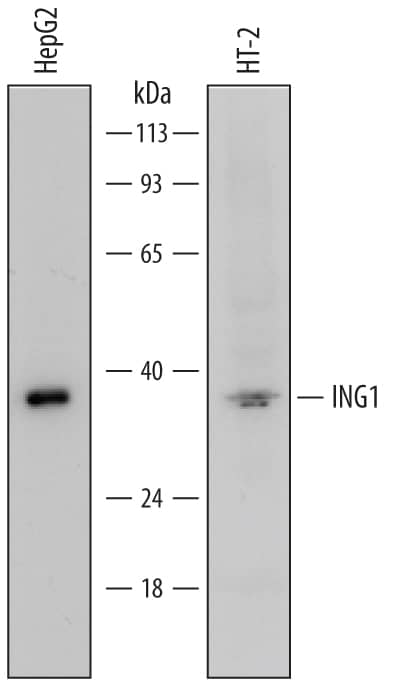Human/Mouse ING1 Antibody Summary
Arg70-Ala184
Accession # Q9UK53
Applications
Please Note: Optimal dilutions should be determined by each laboratory for each application. General Protocols are available in the Technical Information section on our website.
Scientific Data
 View Larger
View Larger
Detection of Human and Mouse ING1 by Western Blot. Western blot shows lysates of HepG2 human hepatocellular carcinoma cell line and HT-2 mouse T cell line. PVDF membrane was probed with 1 µg/mL of Mouse Anti-Human/Mouse ING1 Monoclonal Antibody (Catalog # MAB5758) followed by HRP-conjugated Anti-Mouse IgG Secondary Antibody (Catalog # HAF007). A specific band was detected for ING1 at approximately 35 kDa (as indicated). This experiment was conducted under reducing conditions and using Immunoblot Buffer Group 2.
Preparation and Storage
- 12 months from date of receipt, -20 to -70 °C as supplied.
- 1 month, 2 to 8 °C under sterile conditions after reconstitution.
- 6 months, -20 to -70 °C under sterile conditions after reconstitution.
Background: ING1
ING1 (inhibitor of growth-1) is a member of the ING family of tumor suppressive and apoptosis-promoting epigenetic regulators of chromatin structure. They interact with and alter the ratio of pro- and anti-apoptotic Bcl-2 family members. The p53 tumor suppressor and its downstream targets can potentiate ING1-induced apoptosis. Human isoforms p33ING1, p24ING1c, p33ING1b and p47ING1a vary in N-terminal sequence, resulting in 279, 210, 235 and 422 aa proteins, respectively. The sequence used as an immunogen is common to all isoforms, and shares 83% and 81% amino acid (aa) identity with mouse and rat ING1, respectively.
Product Datasheets
Citation for Human/Mouse ING1 Antibody
R&D Systems personnel manually curate a database that contains references using R&D Systems products. The data collected includes not only links to publications in PubMed, but also provides information about sample types, species, and experimental conditions.
1 Citation: Showing 1 - 1
-
Chromatin condensation and recruitment of PHD finger proteins to histone H3K4me3 are mutually exclusive
Authors: Jovylyn Gatchalian, Carmen Mora Gallardo, Stephen A. Shinsky, Ruben Rosas Ospina, Andrea Mansilla Liendo, Krzysztof Krajewski et al.
Nucleic Acids Research
FAQs
No product specific FAQs exist for this product, however you may
View all Antibody FAQsReviews for Human/Mouse ING1 Antibody
There are currently no reviews for this product. Be the first to review Human/Mouse ING1 Antibody and earn rewards!
Have you used Human/Mouse ING1 Antibody?
Submit a review and receive an Amazon gift card.
$25/€18/£15/$25CAN/¥75 Yuan/¥2500 Yen for a review with an image
$10/€7/£6/$10 CAD/¥70 Yuan/¥1110 Yen for a review without an image

